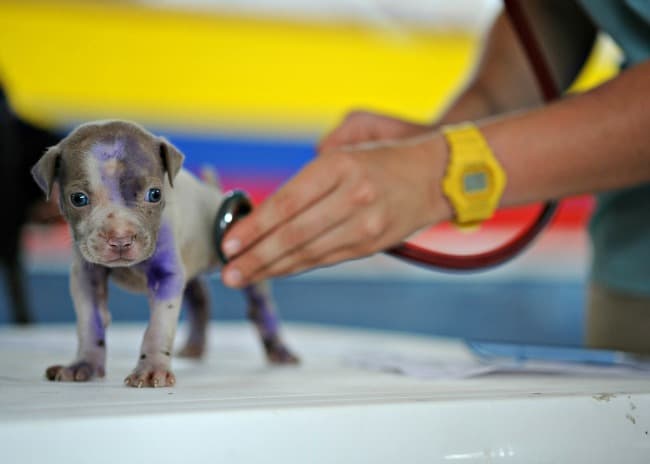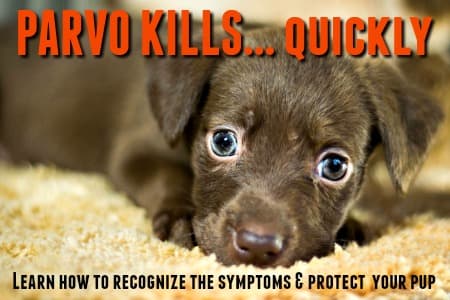FYI: If you buy something through a link on this site I may earn a commission - at NO extra cost to you.
About Dog Illnesses
Dog illnesses can be mild, severe or even deadly and there are a wide variety of symptoms, some of which are found in several different conditions.
For many dog owners it's impossible to tell the difference between a benign or mild illness and something serious, especially in the early stages, so if your dog seems unwell or is acting in way that's not normal for him, it's important to have him examined by a veterinarian sooner rather than later.
The earlier you treat a problem the quicker it will be to resolve, and the less costly the treatment.
For your peace of mind, puppy and dog health information on this site has been approved by veterinarian Dr. Megan Teiber, DVM

Common Symptoms of Dog Illnesses
- Eye discharge
- Swollen lymph nodes
- Skin inflammation/rash
- Disorientation
- Shaking or trembling
- Convulsion
- Behavioral changes (eg. panting, pacing, whining)
- Itching
- Hair loss
- Inflamed or irritated skin
- Excessive thirst
- Loss of appetite
- Increased appetite
- Weight loss
- Weight gain
- Difficulty breathing
- Bad breath
- Lameness
- Loss of co-ordination
- Disorientation
Many of the most common symptoms listed above are found in a number of different diseases and conditions. There can also be less obvious signs that something is not right
Vomiting, Diarrhea, Lethargy, Fever
Diarrhea, vomiting and lethargy are extremely common and can be signs of anything from a simple tummy upset to a very serious illness.
If your pup or dog also has a fever he could have a contagious illness
Nasal Discharge, Eye Discharge, Fever, Cough
These four symptoms (or any combination of them) could signal contagious diseases such as
Other contagious canine illnesses or diseases include...
Non-Contagious Canine Illnesses

There are all sorts of conditions which can make our dogs ill, but which aren't contagious. It could be something they're born with, or a degenerative condition, or caused by an accident/parasites/poisoning etc. Below are the most common dog illnesses which are not contagious, click on any link to learn more about a specific condition...
- Liver Disease
- Kidney Disease
- Auto-immune Diseases
- Heart Problems
- Cancer
- Bloat
- Periodontal Disease
- Poisoning
- Depression
- Hypothermia
- Obesity
Is it an emergency??
Being able to recognize the signs of a medical emergency in your dog could save his life by helping you to decide whether or not Fido needs an trip to your veterinarian or a 24 hour emergency pet hospital.

Leptospirosis
Leptospirosis is a bacterial disease affecting the urinary system, including liver and kidneys. Mainly transmitted through infected urine. It is possible for dogs to transmit Leptospirosis to human family members.
Symptoms:
Loss of appetite, vomiting, lethargy, fever. More advanced symptoms include jaundice, increased thirst and dehydration due to frequent urination.
Treatment:
Early antibiotic treatment can lessen the severity and/or duration of this illness.
Parainfluenza
A highly infectious viral infection of the respiratory system. Easy airborne transmission through coughing and sneezing.
Symptoms:
Include a runny nose, cough and fever.
Treatment:
Mostly supportive, with antibiotics being given for secondary infections.
Rabies
One of the most well-known, and feared, dog illnesses. A severe and usually fatal virus that affects the brain and nervous system. Transmitted through saliva. Once symptoms appear this illness is always fatal to both dogs and humans.
Symptoms:
Are behavioral and usually include unusual, irrational and frenzied aggression (if your dog was very shy you may see a increased affection or acute shyness if previously friendly). You may also see lack of co-ordination, seizures and the classic foaming at the mouth.
Treatment:
There is no treatment for Rabies and the disease is always fatal.
Canine Hepatitis
Highly contagious viral disease which affects the liver. Starts in tonsils, spreads to lymph nodes, bloodstream and liver. Can be transmitted through urine, feces and saliva.
Symptoms:
Similar to Distemper. Severe cases can progress rapidly and cause sudden death.
Treatment:
Mainly supportive care which may include IV fluids and medications.
Puppy Strangles
Also known as Juvenile Cellulitis, Puppy Pyoderma, Sterile Granulomatous Dermatitis or Lymphadenitis. Fairly uncommon.
An autoimmune disease which usually appears suddenly in puppies under 4 months of age. May have a hereditary component as some breeds are predisposed to developing it. Needs to be treated quickly to avoid serious, or fatal, consequences.
Symptoms:
Generally begin with generalized swelling of the puppy's face, but the most noticeable symptom is extreme swelling of the lymph nodes under the jaw and around the neck.
As this progresses it looks as though the puppy is being 'strangled' by the swelling, hence the name. Painful pimples and pustules then develop over the head/muzzle/ears.
Swelling might occur in other lymph nodes and joints, pustules may spread across the body, plus a puppy could lose his appetite and/or have a fever.
Treatment of Puppy Strangles:
Treatment usually consists of corticosteroids to reduce the swelling and inflammation, and antibiotics to kill off any secondary infection that has set up in the affected areas.
If your pup has a severe case, other treatments might be needed, or the standard treatment may need to be maintained for a longer period.
Panosteitis
'Pano' is a condition that is most often seen in medium, large or giant breed puppies. Caused by inflammation of the bones, usually in the front legs and it affects puppies between 6 and 18 months old.
A self-limiting disease which means that the majority of puppies will grow out of it without any treatment and without lasting side effects.
Symptoms:
Usually a puppy with Panosteitis will have some pain in his legs, and will limp intermittently. Often displays no sign of tenderness to the touch and will allow leg/s to be felt, moved without complaint.
It's usually worse in the morning, after rest, or at the beginning of a walk or play session. Then the puppy 'walks it off' and seems fine.
Usually a pup will suffer on and off for 3 - 6 months and then recover. Occasionally it can be longer.
Occasionally a pup will have a fever, seem lethargic or lose his appetite as well. If this happens he needs to be seen by a vet because treatment might be needed.
Treatment:
Most puppies recover fully without treatment and Pano is just a nuisance, but if your pup has a lot of pain or other symptoms then your vet might prescribe corticosteroids or other anti-inflammatory medications to help him feel better.
Cancer
Cancer happens when cells grow in an unnatural, out of control, way. These cells are dangerous and can affect not only the organ or area they originate in, but can also spread throughout the body.
Causes can be environment, dietary, genetic and more.
There are so many different types of cancer that dogs can get it's impossible to cover all signs and symptoms but I've included the most common ones. Your dog may have only one of them, or several.
Symptoms:
Lumps or swellings, sores that won't heal, weight loss, apptite loss, lethargy, change in bowel habits or stool appearance, weakness, difficulty breathing, trouble peeing or pooping.
Treatment:
Treatment options vary depending on the type and location of the cancer. Lumps or tumors can be removed. Surgery, chemotherapy, radiation, immunotherapy... all the options available to humans are available to our dogs too. Not all cancers can be cured even with aggressive treatment. Quality of life should be considered along with quantity.
Health Alert. New Canine Virus Update
Circovirus is a virus which has previously affected only livestock but has now mutated to the point where it has the potential to be a risk to our dogs because it can cross from one species to another.
Main symptoms of Circovirus are bloody diarrhea, vomiting, lethargy, weakness & loss of appetite.
Other symptoms can include vasculitis (inflammation of blood vessels), rapid heart rate and fluid on the lungs.
Quick diagnosis and prompt treatment give your dog the best chance of survival, so be aware of this very small, but real, risk.
Click on the following link to check out an article written exclusively for this website by veterinarian Dr. Megan Teiber, DVM. In it, she shares tips on how to recognize the signs that your dog is ill, how veterinarians reach a diagnosis, and the best way to keep your dog healthy in the first place. Definitely worth a read!
you might also like...
- Home
- Illnesses & Disease
FTC Disclosure: Some pages on this site contain affiliate links. I may earn on qualified purchases.





